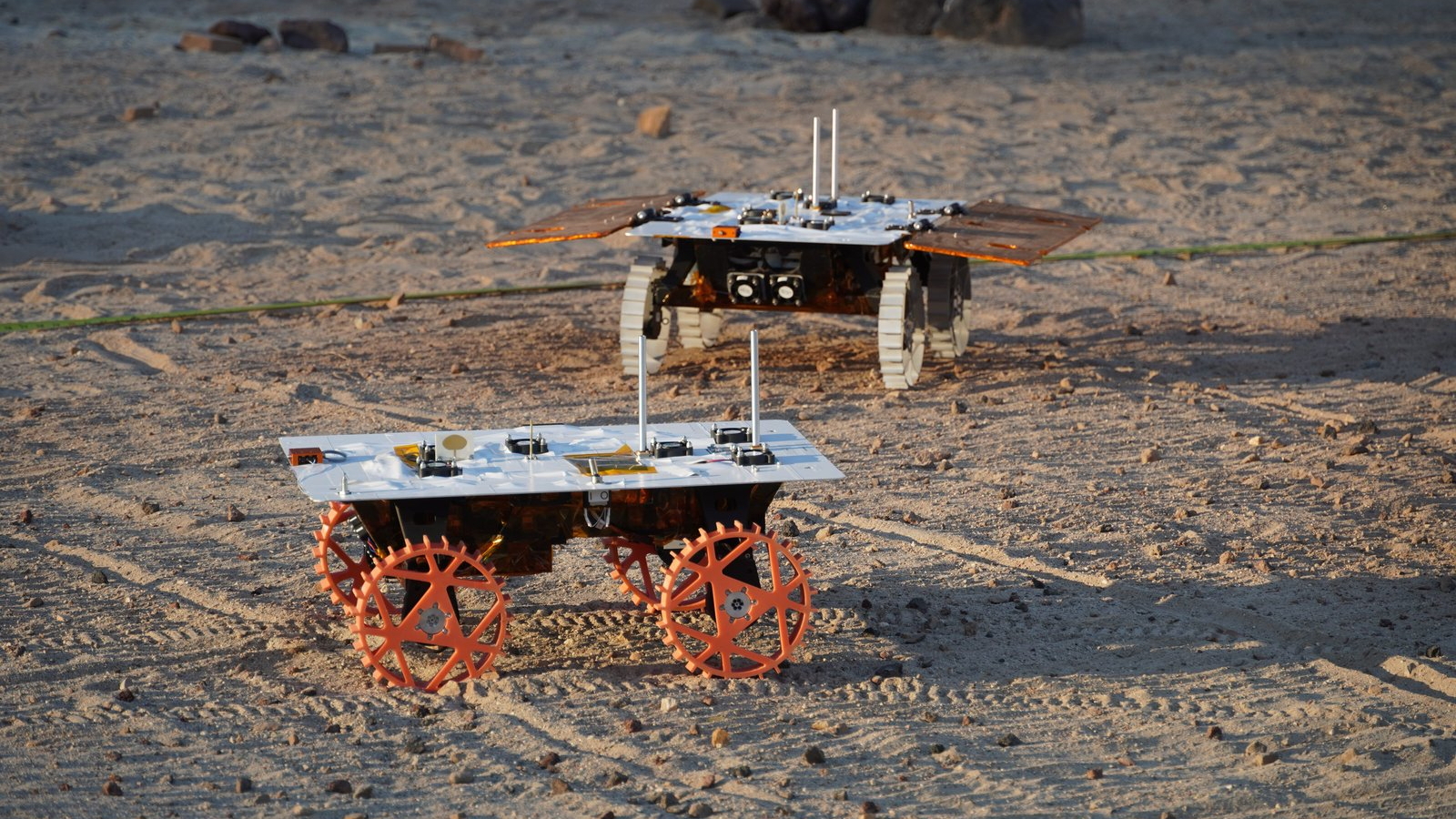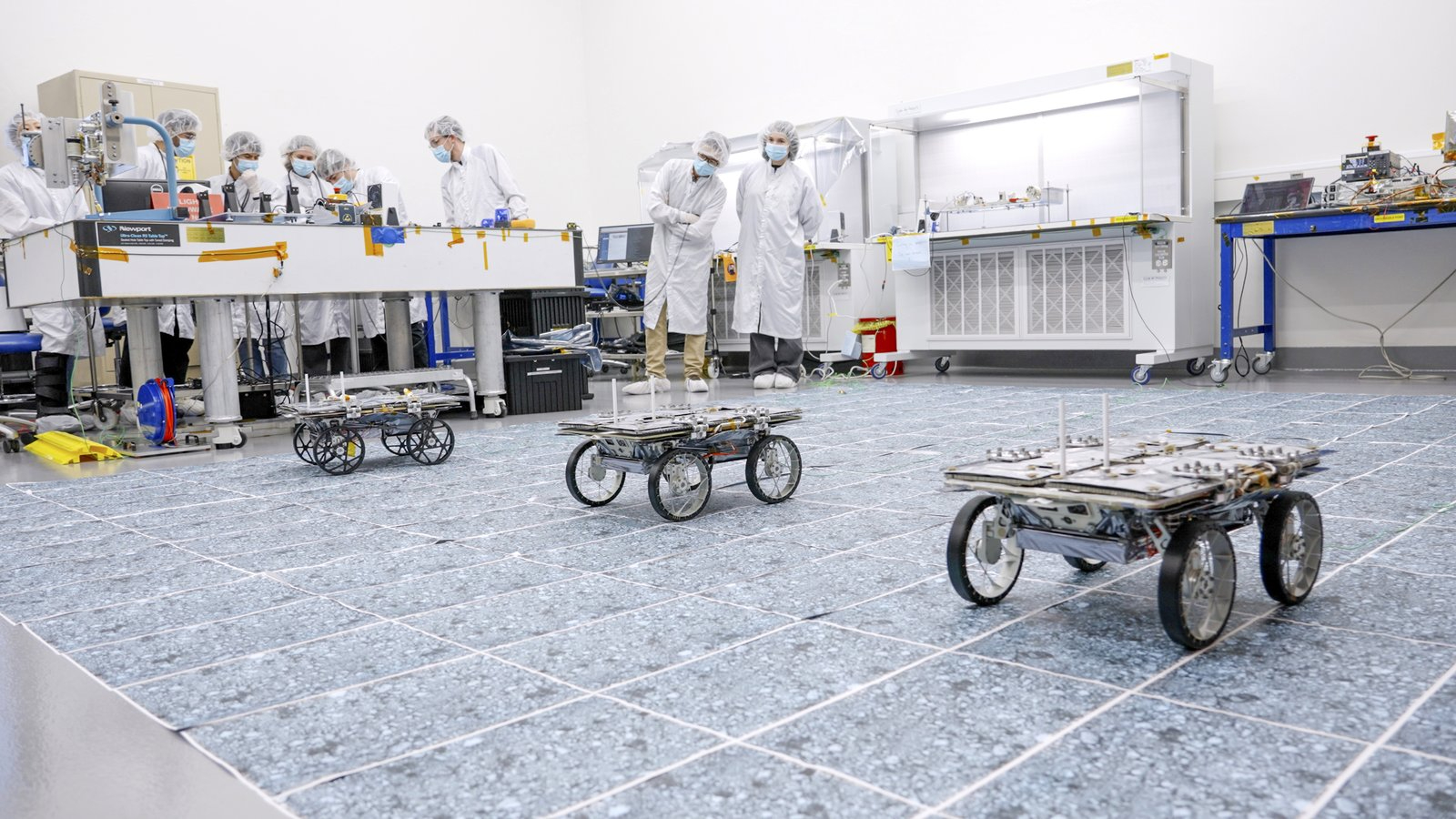
A trio of team-working lunar rovers have been put through their paces at the famous "Mars Yard" at NASA's Jet Propulsion Laboratory (JPL) ahead of their launch to the moon later this year or early next year.
The Cooperative Autonomous Distributed Robotic Exploration, or CADRE, rovers are a trio of suitcase-sized robotic wheeled explorers for which cooperation is the name of the game. They will fly to the moon's Reiner Gamma region on the second mission by Houston company Intuitive Machines, where they will act as a proof of concept to showcase how robots can work together on another world without the explicit interference of humans.
"We have been in overdrive getting this tech demo ready for its lunar adventure," Subha Comandur, the CADRE project manager at JPL, said in a press statement. "It's been nearly round-the-clock testing and sometimes re-testing, but the team's hard work is paying off. Now we know that these rovers are ready to show what a team of little space robots can accomplish together."
Related: The moon: Everything you need to know about Earth's companion

The testing of the rover trio has focused on two main areas. One is evaluating how well CADRE's cooperative autonomous software functions by driving demonstration models of the rovers around JPL's Mars Yard, an outdoor obstacle course for rovers practicing to go to Mars. Now, with more rover missions being planned for the moon, the Mars Yard is pulling double duty as a lunar terrain simulator, too.
When the rovers, which can drive in formation, encounter an obstacle such as a boulder or a steep slope, their software allows them to communicate with each other, sharing maps and formulating the best route forward. They look out for each other, too: When one rover runs low on juice in its solar batteries, the other two rovers wait for their companion's solar array to recharge before continuing together.
The real CADRE rovers that will go to the moon have also been put to work while their doppelgängers have fun in the Mars Yard. The flight models have been test driven in a clean room, on polished floors on which the rovers can slip on and move out of formation — but this doesn't confuse them. They simply communicate with each other, re-adjust their positioning and keep going.
"Dealing with curveballs — that's important for the autonomy," Jean-Pierre de la Croix, CADRE's principal investigator, said in the statement. "We're going to a unique environment on the moon, and there will, of course, be some unknowns. We've done our best to prepare for those by testing software and hardware together in various situations."

Shake and bake
The other part of the testing has been preparing the rovers for the violence of launch and the brutal environment of the moon, where temperature swings and contrasting light and shadow can affect their performance.
In particular, mission engineers have taken a "shake and bake" approach. The "shake" part sees the rovers clamped to a shaker table that simulates the ferocious vibrations that they'll experience during their launch on board a SpaceX Falcon 9 rocket. The "bake" part involves putting the rovers into a thermal vacuum chamber, which can alternate between acting like an oven and acting like a freezer to simulate the extreme temperatures of space.
The tests are "very nerve-wracking to witness in person," said CADRE Projects Flight System Manager Guy Zohar. After all, the hard work that went into building the rovers could go out the window should something go wrong in testing that damages or destroys the rovers. But, "happily, each test has ultimately been successful," Zohar said.
It's not just the rovers that have been subjected to these examinations; it's all the ancillary hardware that will be going with them to the moon on Intuitive Machines' Nova-C lander. This includes a base station that the rovers can communicate with, a camera that can watch over the little rovers' activities and a motorized spool that will deploy the rovers onto the lunar surface via an unwinding fiber tether.
Now that testing is complete, the rovers and their hardware are being shipped off to Intuitive Machines in Houston, where they will be mated to their Nova-C lander. The mission will be Intuitive Machines' second to the moon under the umbrella of NASA's Commercial Lunar Payload Services (CLPS) program. Intuitive Machines' first mission launched a Nova-C lander called Odysseus toward the lunar south polar region on Feb. 15. Odysseus landed on Feb. 22, breaking one or more of its legs in the process, and tipped over shortly after touchdown. Despite the technical difficulties that this incurred, all the NASA experiments toted on the mission were able to successfully return data.
Related: Private Odysseus moon lander broke a leg during historic touchdown (new photos)
Intuitive Machines' second mission is taking the CADRE rovers, among other experiments, to Reiner Gamma. This is a region on the moon marked by a "lunar swirl" — a strange pattern in the terrain linked to anomalous magnetic fields. The CADRE rovers will spend 14 days in broad daylight on the moon, mapping beneath the surface with ground-penetrating radar to see if there is anything there that can explain the lunar swirl. The rovers will shut down after 14 days as lunar night encroaches and cuts off their access to the sunlight needed to keep their batteries charged.
If the CADRE mission is a success, it could lead to more ambitious multi-robot teams that could explore not just the moon, but also Mars in the future.







